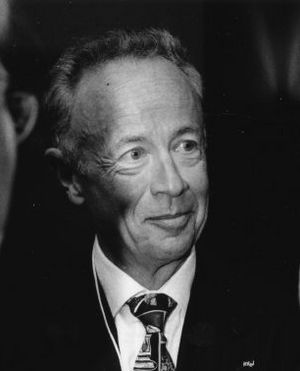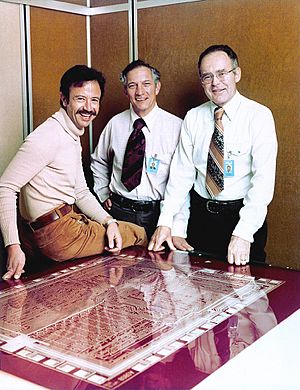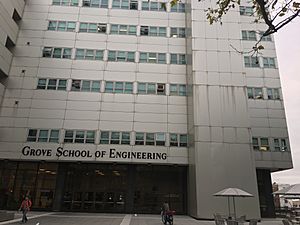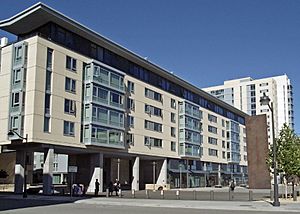Andrew Grove facts for kids
Quick facts for kids
Andrew Grove
|
|
|---|---|

Grove in 1997
|
|
| Born |
András István Gróf
September 2, 1936 Budapest, Hungary
|
| Died | March 21, 2016 (aged 79) Los Altos, California, U.S.
|
| Education | University of California, Berkeley (Ph.D) City College of New York (BS) |
| Occupation | businessman, engineer, senior advisor |
| Known for | third CEO of Intel Corporation, first COO and third employee, 1968 |
|
Notable work
|
College textbook, Physics and Technology of Semiconductor Devices (1967) Management book, Only the Paranoid Survive, (1996) |
| Spouse(s) | Eva Kastan (1958–death) |
| Children | 2 |
| Awards | J J Ebers Award (1974) Time Man of the Year, 1997 Chief Executive magazine, CEO of the Year, 1997 |
Andrew Stephen Grove (born András István Gróf; September 2, 1936 – March 21, 2016) was a Hungarian-American businessman and engineer. He was the third CEO of Intel Corporation. At age 20, he escaped from Communist-controlled Hungary and moved to the United States. There, he finished his education. He was Intel's third employee and later its third CEO. He helped turn Intel into the world's largest company making semiconductor chips.
Because of his work at Intel, along with his books and articles, Grove greatly influenced electronics companies worldwide. Some people called him the "guy who drove the growth" of Silicon Valley. In 1997, Time magazine named him "Man of the Year." They said he was "the person most responsible for the amazing growth in the power and the innovative potential of microchips." Many believe his achievements at Intel alone make him one of the greatest business leaders of the 20th century.
In 2000, he was diagnosed with Parkinson's disease. He then helped several groups that research cures for the disease. He passed away at his home on March 21, 2016.
Contents
Early Life and Education
Andrew Grove was born András István Gróf in Budapest, Hungary. His family was Jewish and middle-class. When he was four, he got scarlet fever, which almost killed him and caused some hearing loss.
When he was eight, the Nazis took over Hungary. They sent many Jews to concentration camps. To stay safe, Grove and his mother used fake names and were hidden by friends. His father was arrested and forced to work in a labor camp. He was reunited with his family after the war.
In 1956, when he was 20, Grove left his home during the Hungarian Revolution of 1956. He escaped into Austria. He had no money and could barely speak English. In 1957, he made his way to the United States. He later changed his name to the more English-sounding Andrew S. Grove.
Soon after arriving in the U.S., he met Eva Kastan, an Austrian refugee, in 1957. They met in New York while he worked as a busboy and she was a waitress. They married in June 1958 and stayed married until Grove's death. They had two daughters and eight grandchildren.
Even with little money, Grove loved to learn. He earned a bachelor's degree in chemical engineering from the City College of New York in 1960. He then got his Ph.D. in chemical engineering from the University of California, Berkeley in 1963.
Career at Intel
Starting Intel
After getting his Ph.D. in 1963, Grove worked at Fairchild Semiconductor. By 1967, he was an assistant director there. His work helped him learn about early integrated circuits, which led to the "microcomputer revolution" in the 1970s. In 1967, he wrote a college textbook called Physics and Technology of Semiconductor Devices.
In 1968, Robert Noyce and Gordon Moore started Intel. Grove joined them on the very first day, though he was not a founder. He was Intel's director of engineering and helped set up its first factories. In 1983, he wrote a book, High Output Management, sharing his ideas about manufacturing.
At first, Intel made memory chips for large computers. But in the 1970s, Intel created one of the first digital watches and electronic calculators. They also made the world's first general-purpose microprocessor, the 4-bit 4004. By 1974, Intel had the 8-bit 8008, and then in 1975, the 8080 processor. This chip became the heart of the Altair, the first "personal computer" (PC), starting the PC revolution. Later came the 8086 and 8088 chips, which IBM chose for its IBM PC. This brought personal computers to many people. In 1985, Intel made the 32-bit 80386 microprocessor, leading to a long line of powerful chips like the Pentium. All this happened under Grove's leadership.
By 1985, Intel faced tough competition in memory chips. Grove had to make big changes. He decided to stop making DRAM memory chips and focus only on microprocessors. Grove helped convince IBM to use only Intel microprocessors in all their new personal computers.
Intel's income grew from $2,672 in its first year to $20.8 billion in 1997. Grove became Intel's president in 1979, CEO in 1987, and chairman of the board in 1997. In May 1998, he stepped down as CEO because he had prostate cancer. He remained chairman until 2004. After that, Grove stayed at Intel as a senior advisor and also taught at Stanford University.
Grove is known for changing Intel from a memory chip maker into the world's top producer of microprocessors for PCs and servers. While he was CEO, Intel's value grew by 4,500%, from $4 billion to $197 billion. It became the world's 7th largest company, with 64,000 employees. Most of Intel's profits were put back into research and development to make better and faster microprocessors.
Management Methods and Style
As director of operations, Grove focused on manufacturing. His management style used many of his own ideas. As Intel grew and he became chairman, he got more involved in big decisions. This included finding markets for new products and working with smaller companies.
Grove helped create the Intel Architecture Laboratory (IAL) in Oregon. This ensured that software was ready for their new microprocessors. Grove said, "you are making decisions about what the information technology world will want five years into the future..."
Only the Paranoid Survive
As CEO, Grove wanted his managers to always try new things and be ready for changes. He believed it was good to be "paranoid" in business. His famous saying was: "Only the paranoid survive." He even wrote a book with that title. He told his leaders to let people test new ideas, products, and ways of selling. This way, they would be ready for unexpected shifts in business or technology.
Strategic Inflection Points
Grove made popular the idea of a "strategic inflection point." This is a key moment when a company needs to make a major change in its plan because the business world is shifting. A company's growth depends on seeing these points and handling them well.
Strategic inflection points cause a mismatch between a company's current plans and changes in the industry. Grove called this "strategic dissonance." To fix this, he said, a company must change its plans to fit the new reality. This means leaders must always check and adjust their company's strategies to keep up with changes.
Grove believed that "Helpful Cassandras" were very important. These are people who warn about problems and challenge common ideas. He stressed that companies should listen to these warnings and act on them, instead of ignoring them. This helps identify and fix problems before they get too big.
Competitive Mindset
Grove had a very strong competitive mindset. He saw competition as the main way to drive new ideas and progress. He encouraged companies to aim to be leaders in their industry. He wanted them to always find ways to make their products and processes better. He saw himself as a coach and believed managers should motivate employees to do their best. He thought a "good fear" could be helpful.
Constructive Confrontation
Grove encouraged open communication at Intel. Employees were told to speak their minds in a "constructive confrontation" way. Ron Whittier, an Intel Senior VP, said, "People here aren't afraid to speak up and debate with Andy." Grove's successor, Craig Barrett, said, "It's give and take, and anyone in the company can yell at him. He's not above it." Grove wanted people to be demanding of each other, which created an atmosphere of "ruthless intelligence."
Egalitarian Ethos
Grove believed that knowledge was more powerful than a job title. He made this idea part of Intel's workplace culture. He said, "We argue about issues, not the people who advocate them." At Intel, there were no special perks for executives, like private dining rooms or parking spots. Grove's own office was a standard 8 by 9 ft (2.4 by 2.7 m) cubicle. This showed his wish for an equal atmosphere. He disliked fancy "mahogany-paneled corner offices." He said, "I've been living in cubicles since 1978 — and it hasn't hurt a whole lot." His workspace was open to anyone who walked by.
This workplace culture reflected Grove's personal life. He was known for being humble and not showing off. He lived simply, without luxury cars or private planes.
Attention to Detail
Grove was known for making sure important details were never missed. One of his favorite sayings was, "the devil is in the details." Intel Vice President Dennis Carter said, "Andy is very disciplined, precise, and detail oriented." Grove worried that Intel's early brilliance "might come to nothing if somebody didn't pay attention to details." Carter remembered that Grove would even correct his spelling errors, even though English was Grove's second language.
"The Father of OKR" (Objectives and Key Results) Approach to Management
John Doerr, an early investor in Google, called Andy Grove the "Father of OKRs." OKR stands for Objectives and Key Results. This became a key part of Google's culture. It's a way of managing that helps a company focus everyone's efforts on the same important goals. The "objective" is the clear goal, and the "key results" are specific ways to measure if the goal was met. These results must be "measurable and verifiable."
In 1975, Doerr took a course at Intel taught by Andy Grove. There, he learned about OKRs. Grove explained his simple idea: "The key result has to be measurable. But at the end you can look, and without any arguments: Did I do that or did I not do it? Yes? No? Simple. No judgments in it."
Larry Page, who co-founded Google, said that OKRs helped Google grow "10x" (ten times) many times over. He said they helped Google's big mission of "organizing the world's information" become possible.
Views on the American Economy
Grove supported new technology companies, but he also believed that these companies alone would not create enough jobs in America. He wrote in a 2010 article for Bloomberg, "Startups are a wonderful thing, but they cannot by themselves increase tech employment." He worried about a society with highly paid people doing high-value work, but many others unemployed.
He felt that job growth depended on companies growing their operations within the U.S. Grove noted that while American investments in startups had grown, they resulted in fewer jobs in the U.S. He said American tech companies were adding jobs in Asia "like mad." He worked to keep Intel's manufacturing in the U.S., with the company having 90,000 employees in 2010.
To fix this, he strongly believed that "job creation" should be America's top goal, like it is in Asian countries. He suggested ideas like taxing imported products. The money from these taxes could then help American companies grow their operations in the U.S. He knew his ideas might be seen as controversial.
Grove also believed that internet sales made to other states should be taxed. He told a Congressional committee in 2000 that "electronic commerce needs federal or state subsidies in terms of tax advantages." At the same meeting, he shared his thoughts on internet privacy. He said that "personal data is a form of property and it's inevitable that governments will regulate property rights." He thought it would be better if the U.S. government made its own privacy rules instead of states having many different laws.
Writing and Teaching
Grove was also a well-known author and scientist. His first book on semiconductors, Physics and Technology of Semiconductor Devices (1967), was used by many top universities. He also wrote a book on business methods, High Output Management (1983). He wrote over 40 technical papers and had several patents for semiconductor devices.
Grove wrote Only the Paranoid Survive (1996), a business book. Its main message is that a company always needs to work hard to stay ahead of its competitors.
He also taught advanced computer physics courses at the University of California, Berkeley and the Stanford Graduate School of Business.
Philanthropy
In 2005, Grove made the largest donation ever received by the City College of New York (CUNY). His $26 million gift changed the CCNY School of Engineering into the Grove School of Engineering.
Grove also helped raise money to build the University of California, San Francisco's Mission Bay Campus. This is the largest ongoing biomedical construction project in the world. Chancellor Sam Hawgood said Grove's "generous and tireless support of UCSF has transformed our university and helped accelerate our research into breakthrough treatments and better patient care."
He helped fund research centers like the UCSF Prostate Cancer Center and the Helen Diller Family Cancer Research Building. He also supported general surgery and various women's health research programs.
Grove was a long-time member of the International Rescue Committee (IRC). He was also a founding supporter of the IRC's Pathways to Citizenship program. In 2010, the IRC honored him as one of ten distinguished refugees. In an interview in Esquire magazine in 2000, Grove encouraged the United States to be "vigilant as a nation to have tolerance for difference, a tolerance for new people." He said that immigration and immigrants are what made America what it is.
Honors and Awards
- Grove received honorary degrees from the City College of New York (1985), Worcester Polytechnic Institute (1989), and Harvard University (2000).
- He was named Time Person of the Year in 1997.
- In 2004, the Wharton School of Business called him the "Most Influential Business Person of the Last 25 Years."
- He received the 1st Annual Heinz Award in Technology, the Economy and Employment in 1995. The award recognized him as a young immigrant who achieved great success. The award donors said Grove "has played perhaps the single most pivotal role in the development and popularization of the twentieth century's most remarkable innovation—the personal computer."
- On August 25, 2009, California Governor Arnold Schwarzenegger announced that Grove would be one of 13 people added to the California Hall of Fame.
- He received the Strategic Management Society's Lifetime Achievement Award (2001).
- He was given the IEEE Medal of Honor (2000).
- He was named IndustryWeek Technology Leader of the Year (1997).
- He was named Chief Executive magazine's CEO of the Year (1997).
- He received the Medal of Achievement from the American Electronics Association (1993).
- He received the IEEE Engineering Leadership Recognition Award (1987).
- He received the Franklin Institute Certificate of Merit (1975).
Books
- A. S. Grove (1967). Physics and Technology of Semiconductor Devices. Wiley. ISBN 0-471-32998-3.
- A. S. Grove (1988). One on One With Andy Grove. Penguin Putnam. ISBN 0-14-010935-8.
- A. S. Grove (1995). High Output Management. Random House. ISBN 0-679-76288-4. (originally published in 1983)
- A. S. Grove (1996). Only the Paranoid Survive. Doubleday. ISBN 0-385-48258-2.
- A. S. Grove (2001). Swimming Across: A Memoir. ISBN 0-446-67970-4. https://archive.org/details/swimmingacross00andr.
- Robert Burgelman and A. S. Grove (2001). Strategy Is Destiny: How Strategy-Making Shapes a Company's Future. ISBN 0-684-85554-2. https://archive.org/details/strategyisdestin00burg.
- Robert A. Burgelman, Andrew S. Grove and Philip E. Meza (2005). Strategic Dynamics: Concepts and Cases. McGraw-Hill/Irwin. ISBN 0-07-312265-3.
See also
 In Spanish: Andrew Grove para niños
In Spanish: Andrew Grove para niños




